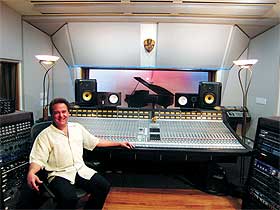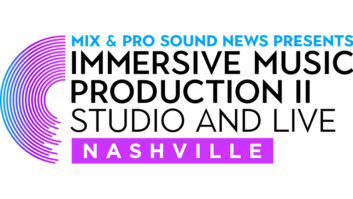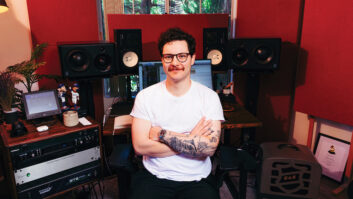
Laughing Tiger owner Ari Rios at the SSL G+ 4052 console in the Studio A control room
Photo: Ray Vargas
Laughing Tiger has thrived as a commercial facility in San Rafael, Calif., since 1995, serving a clientele that ranges from local musicians to San Francisco Bay Area luminaries Carlos Santana, Huey Lewis, Tommy Castro, DJ Shadow and Maria Muldaur, among others. Owner/producer/engineer Ari Rios attributes his studio’s resilience to a combination of timing and foresight.
“I got in right at the tail end of big record budgets, before the whole thing fell apart,” he says. “You had 9/11, Napster and then [Digidesign] released the 002 . When the 002 was released, I said, ‘Everyone’s going to record at home now, but in five or 10 years, a small percentage is going to realize you can’t do it all yourself at home.’ And that has become the reality. People do what they can in their own studios and then do what they can’t in a bigger studio. I welcome that thinking.”
Laughing Tiger comprises Studio A downstairs, offering a large tracking room, control room with a 52-channel SSL G+ 4052 console, dry iso booth, ambient iso booth and lounge; and Studio B upstairs, with a smaller live room for “tighter” acoustics, a control room and a vocal booth. Rios notes that “the plug-ins and amount of DSP in both studios’ Pro Tools HD4 Accel rigs are identical, so you can move a project between studios with no issues.”
Rios says his studio provides “world-class-quality gear, acoustics and service on a sliding scale so that every artist gets the same quality experience at a rate that they can afford, regardless of whether it’s a community or major-label artist. ”
Laughing Tiger In Pictures
The following photos present detailed looks at Laughing Tiger’s rooms. Owner Ari Rios notes that he is planning a tighter integration of the studio’s individual rooms: “My next project is to run tielines between the live rooms and the control rooms of the upstairs and downstairs studios. We’ll then be able to record drums or a horn section in the upstairs live room using the SSL [console] downstairs. And vice versa—if you are in ‘B’ and you want to record the piano or the [Hammond] B3 in the ‘A’ live room, you’ll be able to do that.”
Check out a complete list of Laughing Tiger’s equipment.

Studio A Big Room: Laughing Tiger’s Studio A is the larger of the facility’s two studios, located downstairs. The Studio A live room features a 7-foot Yamaha C7 grand piano. It also offers a Clavinet, Rhodes and Wurlitzer electric pianos, plus a Hammond B3 organ with Leslie speaker cabinet. Studio A offers options for controlling ambience, and additional gobos are available for obtaining varying degrees of isolation. Rios says, “It’s big enough that you can get around 1.3 seconds of reverb time, but it’s also small enough that you can close it down acoustically to get a more intimate, dry sound while still having all the space the room affords.”

Studio A Ambient Iso Booth: “This is an amazing space for recording vocals, acoustic instruments, electric guitars or even drums,” Rios says. “You can ‘open it up’ for a diffused ambient room sound or ‘close it down’ to achieve a drier sound suited for vocals. The varied angles found in this room create a dense and highly diffused ambient field.”

Studio A Control Room: The Studio A control room hosts a Pro Tools HD4 Accel system and is based around Laughing Tiger’s 52-input SSL G+ 4052 console, which incorporates SSL’s Total Recall system, allowing users to recall every control knob and switch to settings stored in a snapshot of mix parameters. The console also features SSL’s Ultimation moving fader system. Sitting atop the console are KRK Exposé 8 and Yamaha NS-10 monitors, with subwoofers below. The racks on each side include many vintage mic pre’s, compressors and effects units.

Studio B Control Room: Rios describes the Studio B control room as “a powerful, intimate and elegant environment designed for overdubbing, editing and in-the-box mixing, et cetera. This room features Meyer HD1 monitors and a subwoofer coupled with a Pro Tools HD4 Accel system and a plethora of your favorite plug-ins. There are also many great vintage mic pre’s, EQs and compressors here.”

Studio B Live Room: “This room is designed to give you a wonderfully bright, tight sound,” Rios says. “It is excellent for overdubbing drums, percussion, guitar, strings, woodwinds and brass. The early reflections found here stop short of the dense ambient field found in the downstairs Ambient Iso, for yet another unique choice in room sound.”

Studio B Vocal booth: “This room has become a sought-after place to cut vocals for artists who feel more comfortable in a smaller studio environment, due to its great sound and intimate vibe,” Rios says. “The dry ambience is just right for vocals and voice-over work, et cetera. There are huge glass doors between the vocal booth and the control room, so you’re almost in the same room with the vocalist but you’re separated acoustically. You can see each other well and it feels less like a big-studio experience.”







